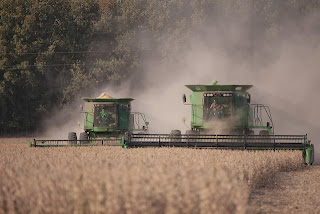The late September USDA crop report for Wisconsin shows that we are a bit behind average on harvested acres for corn and soybeans and well behind last year’s drought-induced early harvest. So, October promises to be a bit rushed for many growers, and conditions appear to be relatively more dusty this fall. Time will be critical, and it’s also crucial that you avoid a costly and potentially devastating combine fire!
A 2002 study showed that crop residue is the material most often first involved in a grain combine fire. Our study of almost 9,000 fires also showed that more than 75% of fires start in the engine compartment, though they tend to often rapidly spread to other parts of the machine. Fires become especially severe when fuel lines rupture from the heat or hydraulic hoses are compromised. When tires become involved in a fire, the result is almost always a near total loss.
Based on what we know, the most critical information is to keep your engine compartment clean of all crop residue and any buildup of greasy/oily material. Different machines have different “patterns” for crop residue buildup in the engine area. This can even change a bit from year to year as a result of conditions (wind, relative humidity, and dustiness). Take time to blow out or find other ways to remove any buildup of crop trash daily or as is needed. All fires need an ignition source. Often, exhaust components (turbochargers, manifolds, mufflers) are involved, but faulty bearings or malfunctioning electrical systems can also be the culprit.
All grain combines need to be equipped with at least two 10-pound ABC dry chemical fire extinguishers. Larger ones are even more preferable, though they are a little more clumsy to handle. Avoid new “high tech” fire suppression liquids (that I often see being sold in spray cans at farm and machinery shows) unless they are tested and explicitly approved for dry, cellulosic-type material (crop residue) AND liquid fuels by Underwriter’s Laboratory. The “ABC” compound means the extinguisher will work on Class A crop residue, Class B flammable liquids, and is non-conductive so it can be used on electrical components.
If you do experience a fire, pull away from the standing crop and shut the machine down. Call for help. Use your extinguisher(s) with great care and fight the fire by aiming at the base of the flames. Again, the engine must be shut off or air movement will simply fan the fire and blow the extinguishing powder out. Also, if you experience even a small fire that you are able to put out, correct the problem that caused it before you resume and make sure to contact your insurance company. Harvest is the most dangerous time of the year. Be proactive and careful to protect your safety and your investment!
Below Caption –
First Material to Catch Fire in 8,927 U.S. Grain Combine (Harvester) Fires
Below Caption –
Fire Origin Location for 8,927 U.S. Grain Combine (Harvester) Fires
Reference
Venem, M.T., W. Gilbert and J. Shutske. 2002. Combine Fire Prevention Summit. ASAE Paper No. 028017. St. Joseph, Mich.: ASAE.
Article from:
John M. Shutske, PhD
Associate Dean and Program Director
Agriculture and Natural Resources Extension & Outreach
College of Agricultural and Life Sciences
University of Wisconsin – Madison








